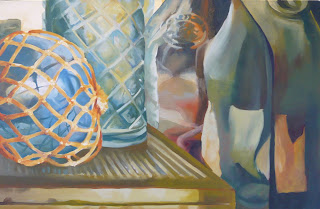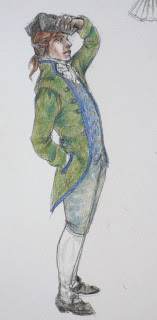This is the very first piece we made. It is a self-portrait done with a glazing technique on a 9" x 12" canvas. I used oil paint and a glazing medium a liquin original on this piece. Glazing involves laying down several layers of translucent paint (one at a time) over top of each other. This way the colors are not blending physically, like mixing colors on a palette, but optically. For example, when yellow undertones shine through a translucent layer of blue, they appear green.

This is another self-portrait on a 9" x 12" canvas. For this piece, we had to paint ourselves in one sitting, experimentally mixing all sorts of usual colors together while the paint was still wet. Also, my professor had us paint the canvas completely with Alizarin Crimson (red) first!

This is the final self-portrait we did but we painted it intaglio. Impasto is painting with very thick amounts of paint so that ever brush stroke or scrape of the palette knife is visible. Vincent van Gogh is famous for using this technique.

One class, we all took a field trip to a very beautiful and big park in Richmond called Maymont Park. We painted little landscapes in the Japanese garden there. In my painting, I have a dramatically high horizon line, thus focusing more on the reflection of nature in the water than the actual physical trees and bushes. The tree does some very interesting things; the shadow from the tree diagonally points to the left but the reflection switches to the right.
We painted a still life on the first of our large hand-made canvases. My teacher set up several still lifes, one of all glass objects, one of all metallic/reflective objects, one of all white objects, and one of all wooden objects. I chose to paint the glass still life because I liked the assortment of bottles and I wanted a challenge. My painting looked so much different (not as good) for our still life critique; since then, I painted over all of it for my final critique with my professor. I'm glad I redid it because it so much better!



Here again is the portrait piece. I did go back into it and repainted the neck to make it match the face color better. I also corrected the circle behind her. Even this looks better now, in my mind.

Then we had a mixed media project. I chose to make another panel for this piece instead of a canvas. My idea for this piece was painted cake, so much cake that it make you sick. I was influenced by Rococo things and Marie Antoinette's quote "Let them eat cake!" I definitely have a love hate relationship with Rococo Art. It's very pretty and whimsical but it is art for rich people about being rich. I tried to illustrate this through the disgusting amount of sweetness. I did not use any really food! Instead I used polymer medium and gel to create the illusion of frosting. Polymer medium and gel are used with acrylic paint. They allow you to extend the quantity of your paint by mixing a little bit of paint pigment (or color) into a large about of medium. I used the medium and gel for their physical characteristics. Polymer medium is very soupy and dries clear when it's used by itself. The gels come in different viscosities. There are heavy gels, smooth gels, regular gels, etc. I selected the get that had the same viscosity as frosting to mix with my paint. Then I put that "frosting" into a cake decorating bag with tip and literally frosted my panel. I had laid down objects, like clocks, frames, and modeling, along with insulating foam to give my panel more dimensions of depth. All of the little "candies" were made out of polymer clay. I had so much fun on this piece!!!




The last piece we did was a free choice. I chose to paint a cityscape of a place in my sister's most recent novel. This city, a legendary city, is lit by a giant moon rather than the sun. This might one of my favorite paintings that I did this semester (the portrait being my favorite)!



































